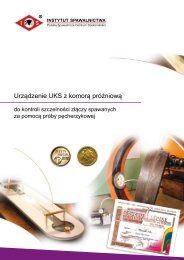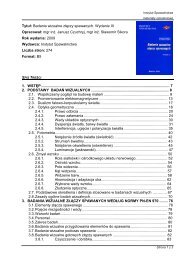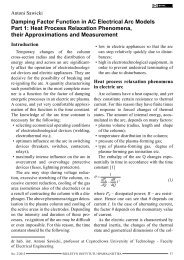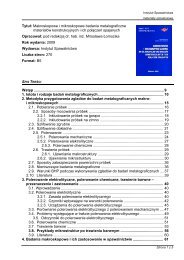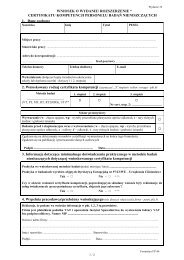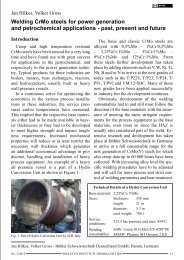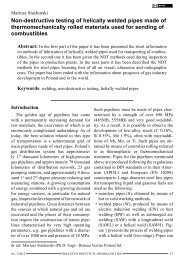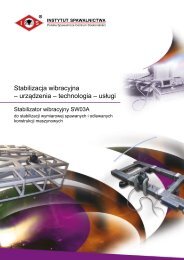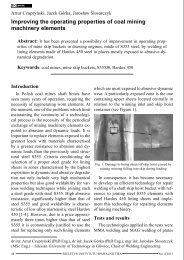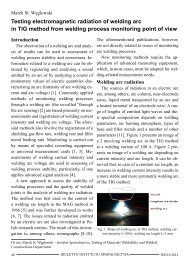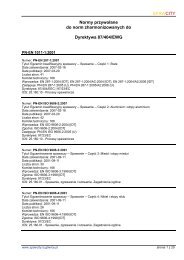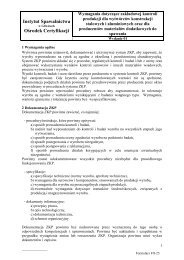Biuletyn Instytutu Spawalnictwa No. 01/2012
Biuletyn Instytutu Spawalnictwa No. 01/2012
Biuletyn Instytutu Spawalnictwa No. 01/2012
You also want an ePaper? Increase the reach of your titles
YUMPU automatically turns print PDFs into web optimized ePapers that Google loves.
extreme, the process was less stable, repeatability<br />
was lower, and spatters became bigger,<br />
which significantly deteriorated the aesthetics.<br />
Another purpose of the research was to<br />
investigate the impact of EN ratio on the course<br />
of a welding process as well as on the quality<br />
and aesthetics of welded joints. The plates<br />
used for the tests were 1.5 mm thick, made<br />
of steel grade DX 53 D ZF 100 RBO and provided<br />
with a zinc-iron protective coating. The<br />
tests involved the production of overlap joints<br />
for various parameter settings and in constant<br />
welding conditions (filler wire feeding rate<br />
and welding rate). During the process, assessment<br />
was connected with the process stability.<br />
After the completion of the process, each<br />
joint underwent a visual inspection. The criterion<br />
used in the evaluation of the selection<br />
of parameters and welding conditions was the<br />
quality level B according to standard PN-EN<br />
ISO 5817 [8]. Another process-related criterion<br />
was the smallest possible damage to the<br />
zinc-iron layer. A visual inspection of joints<br />
produced at various settings of EN ratio revealed<br />
that practically in the whole range of<br />
EN ratio settings (except for extreme ones) it<br />
is possible to obtain joints<br />
of a very good quality. The<br />
smaller the EN ratio in the<br />
course the greater the damage<br />
to a zinc-iron layer<br />
near a weld. A decrease in<br />
EN ratio resulted in an increase<br />
in heat supplied to<br />
the material being welded<br />
which was manifested by<br />
an increased width of the<br />
joint overheating-affected<br />
area, greater deformations,<br />
and local burn-throughs of<br />
elements being joined.<br />
NR <strong>01</strong>/2<strong>01</strong>2<br />
BIULETYN INSTYTUTU SPAWALNICTWA<br />
Technological tests of welding of various<br />
steels with protective coatings<br />
The next stage involved technological tests<br />
related to the welding of various joints (butt,<br />
T-shaped and overlap joints) made of plates of<br />
various thicknesses. Tests revealed that MAG<br />
welding with variable polarity current makes<br />
it possible to obtain butt, T-shaped, and overlap<br />
joints characterised by very good quality.<br />
Apart from technological parameters, the basic<br />
variable affecting the possibility of joining<br />
elements and the course of a welding process<br />
is the EN ratio. Welding of thin elements is<br />
most advantageous if accompanied by a high<br />
EN ratio as it translates to small deformations<br />
and minimum damage to the zinc-iron layer. In<br />
turn, T-shaped and butt joints of greater thicknesses<br />
should be welded with a lower EN ratio<br />
as the process of welding is more “energetic”<br />
(i.e. heat input is higher). According to the test<br />
results, the appropriate selection of technological<br />
parameters makes it possible to produce<br />
overlap and butt joints of plates having as little<br />
as 0.75 mm and 0.8 mm thicknesses. Figures<br />
8-10 present selected joints and their macrostructure.<br />
Fig. 8 General view and macrostructure of overlap joint of 0.75mm-thick steel<br />
DX56D ZF100 RBO; etchant: Adler, magnification x8<br />
37



